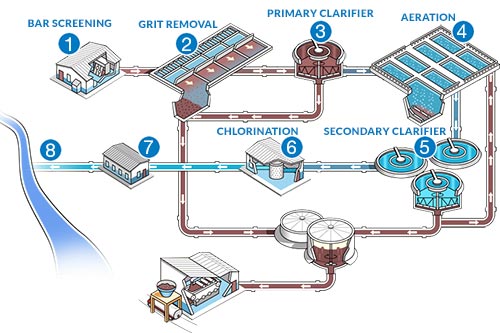The Link Between Wastewater Management and Public Safety
The Link Between Wastewater Management and Public Safety
Blog Article
Comprehending Wastewater Treatment Processes and Their Environmental Impact
The ins and outs of wastewater therapy processes play a pivotal role in mitigating ecological challenges connected with water air pollution. Each phase, from initial to sophisticated therapies, is made to address certain impurities, ultimately protecting both public health and wellness and water communities. Nevertheless, despite technological improvements in therapy effectiveness, considerable difficulties linger, including the monitoring of recurring toxins and the effects of nutrient runoff. As we discover the intricacies of these procedures, it ends up being important to question how much existing methodologies can develop to meet the growing demands of sustainability and environmental conservation.
Overview of Wastewater Treatment
Just how is wastewater transformed right into a safe resource for the setting? Wastewater treatment is an important process created to remove impurities from utilized water, thereby safeguarding public wellness and safeguarding environments. This process starts with the collection of wastewater from household, commercial, and business sources, which is then routed to treatment facilities.
At these centers, different physical, chemical, and biological techniques are employed to deal with the wastewater. Ultimately, organic therapies, such as triggered sludge procedures, make use of bacteria to damage down natural issue.
The treated effluent can be safely released right into all-natural water bodies or reused for watering and industrial functions, promoting resource conservation. In addition, the treatment process creates biosolids, which can be repurposed as fertilizers or dirt changes, additionally enhancing sustainability.
Phases of Therapy Processes
The wastewater treatment process commonly contains three key phases: preliminary, main, and second treatment. Each stage offers a distinctive role in reducing the contaminant tons and ensuring the effluent fulfills ecological criteria before discharge.

The primary treatment stage concentrates on the physical separation of put on hold solids from the wastewater. Through sedimentation, heavier bits work out at the end of sedimentation containers, developing sludge, while lighter materials, such as oils and greases, float to the surface area and are skimmed off. This procedure dramatically lowers the natural and inorganic tons in the wastewater.
Second treatment is an organic process intended at more reducing the focus of organic issue. Different approaches, including activated sludge systems and trickling filters, make use of bacteria to metabolize natural contaminants. This phase is necessary for attaining the necessary biochemical oxygen demand (BOD) decrease, eventually bring about cleaner effluent prepared for discharge or more treatment. Each stage is important in guarding ecological and public health.
Advanced Treatment Technologies
Complying with the second therapy processes, progressed treatment modern technologies play a vital duty in additional improving the quality of treated wastewater. These innovations are made to get rid of residual pollutants that are not successfully removed throughout key and second therapies, ensuring the effluent fulfills strict regulatory standards.
Among the commonly made use of advanced therapy techniques are membrane layer purification, reverse osmosis, and progressed oxidation procedures. Membrane purification, consisting of microfiltration and ultrafiltration, is efficient in separating fine particles, virus, and colloids from the water (Wastewater). Reverse osmosis makes use of semi-permeable membranes to eliminate liquified solids, leading to high-quality water suitable for different applications
Advanced oxidation processes (AOPs) employ strong oxidants to break down natural contaminants, consisting of pharmaceuticals and personal care products that are immune to traditional therapy. These approaches boost the biodegradability of complicated substances, facilitating their elimination.
One more considerable modern technology is using biological nutrient removal procedures, which particularly target nitrogen and phosphorus, protecting against eutrophication in obtaining water bodies. In general, advanced therapy modern technologies are necessary for accomplishing higher degrees of filtration, promoting water reuse, and protecting public wellness while resolving the obstacles related to wastewater management.
Environmental Benefits of Treatment
Countless check here environmental advantages occur from effective wastewater therapy procedures that add to ecosystem health and wellness and sustainability. Mainly, these processes significantly lower the launch of hazardous contaminants into natural water bodies, which assists maintain aquatic ecological communities. By eliminating impurities such as hefty metals, nutrients, and virus, dealt with wastewater alleviates the threat of waterborne conditions and advertises biodiversity in aquatic settings.
Furthermore, wastewater treatment facilities frequently use advanced modern technologies that make it possible for water recycling and reuse. This method not just conserves freshwater resources but additionally minimizes the demand on all-natural water products. Improved nutrient elimination from wastewater can also prevent eutrophication, a process that causes algal flowers and subsequent oxygen depletion in water systems.
Furthermore, reliable treatment procedures can lessen greenhouse gas discharges, particularly methane and nitrous oxide, which are often launched during untreated wastewater decay. By capturing and making use of biogas from anaerobic digesters, centers can convert waste into renewable power, consequently adding to a reduction in fossil fuel reliance.
Obstacles and Future Patterns
While the environmental advantages of wastewater treatment are clear, a number of difficulties persist that hinder optimum outcomes in this area. One significant problem is aging infrastructure, which commonly results in inadequacies and boosted functional costs - Wastewater. Numerous treatment plants were designed decades ago, YOURURL.com and their capabilities do not straighten with modern-day needs, which include more stringent regulative requirements and greater volumes of wastewater because of urbanization

Looking ahead, there is a growing focus on source recuperation and round economy principles within wastewater therapy. Developments such as anaerobic digestion, which can produce biogas, and advanced purification innovations are obtaining traction. These techniques not just enhance therapy effectiveness yet additionally advertise sustainability.
Inevitably, resolving these difficulties needs partnership among stakeholders, financial investment in modern technology, and a commitment to recurring research. By embracing these fads, the wastewater therapy sector can evolve to meet the demands of an altering setting and culture.
Final Thought
In verdict, wastewater therapy processes play a crucial duty in improving ecological quality Related Site and public health and wellness. The multi-stage treatment structure, paired with innovative technologies, successfully reduces contamination and advertises lasting water monitoring.
Report this page